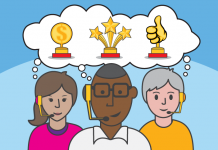
Pay is a critical consideration for most contact center employees in whether they stay or leave, and how they view their role—and many managers have witnessed what a strong demotivator low pay can be. But once employees feel that they’re being fairly compensated for their contributions, daily motivation can be further encouraged by positive feedback and genuine appreciation, and recognition of the value that the individual brings to the team, contact center and organization. The following are three non-financial motivators that can influence frontline behaviors.
INDIVIDUAL RECOGNITION
All age groups respond positively to recognition that is sincere and focused on individual contributions and achievements. In the contact center, linking recognition to customer experience also provides an ideal way to highlight behavior that drives organizational strategies or goals.
“Employees need to know what is expected of them and why a change in behavior is important and worthy of a reward above and beyond salary-based compensation,” says customer experience management expert Janet LeBlanc of Janet LeBlanc + Associates Inc. “Employees also need to know what to do differently to be rewarded. Customer experience reward and recognition programs must be anchored directly to the criteria related to the ideal customer experience with measurable goals in place.” She points to The Walt Disney Co. as an example, which has three primary criteria related to its themepark customer experience: providing a magical experience, attention to every detail, and making every child feel special.
“By linking an employee recognition program to the criteria used to form the ideal experience, organizations emphasize the chosen behaviors needed to create memorable experiences. Doing so also prevents employees from over-exerting their talents in ways that are not aligned with the desired process and therefore potentially inefficient, unproductive or costly to the organization,” LeBlanc states. “An effective employee recognition program not only recognizes top performers, but also motivates all employees to reinforce and achieve the desired customer-focused behaviors.” (For more on how to positively influence agent behavior and cultivate a customer-centric culture, read LeBlanc’s article, “Make Employee Recognition Part of Your CEM Strategy”).
Jesse Hoobler agrees. “It’s easy to give kudos, praise and recognition to employees who are burning the candle at both ends or swooping in to be a hero when they could have done something upstream to prohibit the issue or escalation that took place downstream,” he says. “When developing a reward and recognition program, you need to identify the core characteristics and behaviors that you expect your team to be able to emulate, and then assess how to recognize both individuals and teams that are exhibiting those types of behaviors.” Hoobler is Director, Office of the President at Pitney Bowes, and former Director of Worldwide Software Support.
It’s important to develop the behavioral characteristics before you start rewarding and recognizing employees, Hoobler stresses. “If it’s reactive, your employees will notice that their colleagues are being recognized for super-heroics that could have been prohibited in another way, or they are reinforcing a disjointed work-life balance. That will disincent people from wanting to do things the right way for their customers.”
PUBLIC KUDOS
As a technology company, Pitney Bowes utilizes a variety of tools within the support organization to ensure efficiency and effectiveness in serving clients. One such tool that has been remarkably beneficial in sharing kudos and recognition internally is Chatter, Salesforce’s social collaboration software solution.
The management team is highly active in posting positive feedback from clients on the Chatter site. It allows the entire organization to instantly to see the kudos, and it enables other reps to “like” the comment to show their support for their peers, as well as pick up successful techniques and practices for serving clients.
“It allows for a very dynamic conversation for our geographically diverse organization,” Hoobler says. “We utilize this technology very effectively to communicate what people are doing well, what behaviors are helping our clients to be successful and what we need to continue doing to reinforce that type of behavior.”
TEAM RECOGNITION
The contact center may be the most visible touchpoint between a business and its customers, but what about the other functions that contribute to the customer experience? At Pitney Bowes, recognizing the collaborative effort to serve clients is key.
The company’s “Make a Difference” campaign is a global program that recognizes efforts that require teaming and collaboration across different departments. “It’s very short-sighted to think about recognition programs as only being within one department or silo,” Hoobler says. “That supports an ‘It’s just about me’ mentality. In today’s unique, dynamic environment, it’s incredibly important to recognize the cohesiveness and collaboration that takes place across the departments to serve our clients.”




